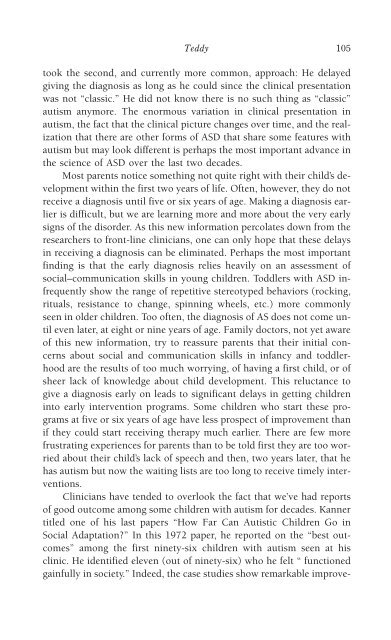978-1572305441
autism
autism
You also want an ePaper? Increase the reach of your titles
YUMPU automatically turns print PDFs into web optimized ePapers that Google loves.
Teddy 105<br />
took the second, and currently more common, approach: He delayed<br />
giving the diagnosis as long as he could since the clinical presentation<br />
was not “classic.” He did not know there is no such thing as “classic”<br />
autism anymore. The enormous variation in clinical presentation in<br />
autism, the fact that the clinical picture changes over time, and the realization<br />
that there are other forms of ASD that share some features with<br />
autism but may look different is perhaps the most important advance in<br />
the science of ASD over the last two decades.<br />
Most parents notice something not quite right with their child’s development<br />
within the first two years of life. Often, however, they do not<br />
receive a diagnosis until five or six years of age. Making a diagnosis earlier<br />
is difficult, but we are learning more and more about the very early<br />
signs of the disorder. As this new information percolates down from the<br />
researchers to front-line clinicians, one can only hope that these delays<br />
in receiving a diagnosis can be eliminated. Perhaps the most important<br />
finding is that the early diagnosis relies heavily on an assessment of<br />
social–communication skills in young children. Toddlers with ASD infrequently<br />
show the range of repetitive stereotyped behaviors (rocking,<br />
rituals, resistance to change, spinning wheels, etc.) more commonly<br />
seen in older children. Too often, the diagnosis of AS does not come until<br />
even later, at eight or nine years of age. Family doctors, not yet aware<br />
of this new information, try to reassure parents that their initial concerns<br />
about social and communication skills in infancy and toddlerhood<br />
are the results of too much worrying, of having a first child, or of<br />
sheer lack of knowledge about child development. This reluctance to<br />
give a diagnosis early on leads to significant delays in getting children<br />
into early intervention programs. Some children who start these programs<br />
at five or six years of age have less prospect of improvement than<br />
if they could start receiving therapy much earlier. There are few more<br />
frustrating experiences for parents than to be told first they are too worried<br />
about their child’s lack of speech and then, two years later, that he<br />
has autism but now the waiting lists are too long to receive timely interventions.<br />
Clinicians have tended to overlook the fact that we’ve had reports<br />
of good outcome among some children with autism for decades. Kanner<br />
titled one of his last papers “How Far Can Autistic Children Go in<br />
Social Adaptation?” In this 1972 paper, he reported on the “best outcomes”<br />
among the first ninety-six children with autism seen at his<br />
clinic. He identified eleven (out of ninety-six) who he felt “ functioned<br />
gainfully in society.” Indeed, the case studies show remarkable improve-



